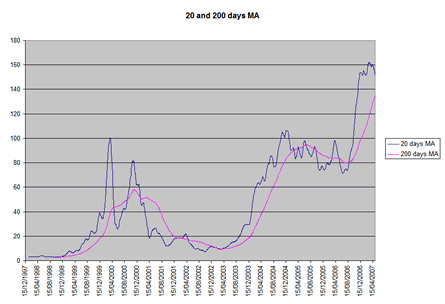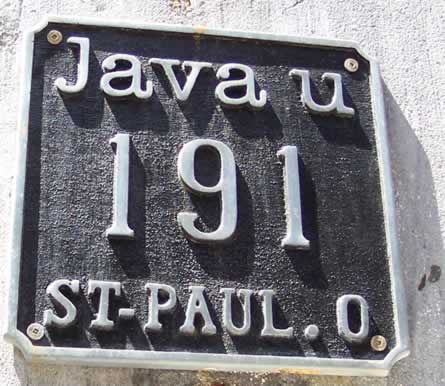I feel google's love
Wednesday, May 30, 2007
I feel the love.
Last year,
I wrote a simple analysis on how much money I had made from all my blog posts. At the time, I think I had made around $30. As per google's policy, they don't mail you a check until accounts reach more than $100.
Well, my time has come: today, I received my first, very own google check for $108.58 CDN. I don't know how much google made because of me, but I'm sure is more than $108.58. All I care, really, is that I got my cut today. We've become professional partners.
This check brings some interesting question forward. For example, why did I get paid? Have I become a professional writer or just an advertising pimp? Can I make a living from blogging? What should I buy with my hard earned money? Should I buy google stock?
So many questions.
Personally, I don't think I could give up coding just yet, but I will definitely keep on writing and making google bucks. As far as buying anything, I'm not sure. Maybe I'll pay a year for josesandoval.com's hosting services and still have some change for a movie or something.
Anyway, let me go back to admiring my first google check. I plan to be a millionaire in
no time.

Who buys facebook images?
Monday, May 28, 2007
Facebook is an interesting site, but only because of its users and not because of the concept. That is the case with some service offerings, though.
The genious of the site, I would think, has been timing. The concept is as old as a web page, however, going through all the motions of buying a domain name and paying for hosting services is still something that is not common knowledge to everyone. It is not hard to do or set up, but it is not as convenient as just creating an account and already have a web page.
I do wonder, though, why Microsoft did not think of it. Google is trying it, but it is not connected to a network of people. Classmates did it in the late 90s, but they tried to charge for their services. Geocities died a mediocre death, yet MySpace thrives in its inelegance. Even I tried it, with a social web site when social networking sites did not exist, but in the end we decided to pull the plug: there was no long term sustainable revenue model but we did have non-paying users (a few of them).
In some cases, it is the phenomenon of timing that saves the day.
What makes the site alive are its users, but I find it interesting that its users are willing to buy "images" as gifts to other users.
Yes, an image. It is something that does not exist; it is only a representation of a thing that lives as long as a computer can be turned on. The tangibility of an image can probably be weighted in the instant it is displayed on a screen, i.e., counting the number of electrons needed to be displayed at a certain point (yes, electrons have a mass). But paying for an icon to be displayed on someone else's facebook page? I do not get it. (Leave aside all the copyright issues, as that is another whole story.)
However, I do welcome the business models that will come up from this experiment. I do understand how the selling of virtual items in
MMORPG is so successful (after all, it is another personality that is created), but selling out of images that cost $1 to display on someone else's facebook page?
It feels wrong, but if the customer wants it the customer will get it.
Would you buy a facebook image? I hope you do not by me one.

Developer toys: take a break from coding and code for fun
There are always interesting things for developers to play with.
This time around, I would recommend you look into the following 3. One of them is more important than the others, but well worth the little time it takes to read and understand them.
- Erlang
There is word that concurrency is not handled well with modern languages. So there is a "new" language that is built around concurrency. There are a few libraries already based on Erlang. The cool thing is that it is open sourced.
And now a silly Java interview question:
Trick question: what are the main problems with concurrency?
Not so tricky answer: multiple threads accessing the same resource.
Trick question: how do you solve this problem?
Typical answer: use locks, i.e., in Java the nifty .wait() and .notify() methods do the trick.
Not so typical answer: do not use shared resources, i.e., use messages to do your stuff. Let it sink in. It makes sense, but you already knew that.
- The Semantic Web
You have lived under a rock if you have never heard the words "semantic web." Well, maybe it is time to play with it. Of course, the benefits of this thing to come to a reality near you have been over-promised for a while, but it is still an interesting aspect of the web.
- Processing
Now this is a real treat. However, this development environment is probably targeted to the more visually inclined in you. This is how their official web site describes it:
Processing is an open source programming language and environment for people who want to program images, animation, and interactions. It is used by students, artists, designers, researchers, and hobbyists for learning, prototyping, and production.
It is all that and more, really. It is actually a high level graphics development programming language based on Java. I think of it more of an API. Download it, code with it, and then you will see what I mean.
In the mean time, check out how useless and fun it is:
So open doesn't mean open
Monday, May 21, 2007
I haven't been following
project red stripe, but out of curiosity I visited their blog today.
It end up being that open doesn't mean open. This is probably a disservice to community generated content when the rules of the game change as the playing gets started.
Not very nice:
Good news, bad news.
I did say that incentives were not aligned for this particular experiment:
contributing users don't get same value as the organizers of the event.
Invest $1,000 and make $34,991.97, but only in theory
Tuesday, May 15, 2007
One of the greatest things about North American stock markets is that every snippet of information is stored somewhere. Every closing price, every split of stock, and every CEO firing and hiring is available to be scrutinized.
Another great thing is that some information is free, for example, historical stock prices. With this type of data you can create pretty pictures such as the one below:

The picture itself gives you a great deal of information and not just aesthetic satisfaction. From reading the graph I can tell you that if I had invested $1,000 in this particular stock I would have made $34,991.97 (if I had liquidated my holdings on May 8, 2007).
Of course, I didn't make that money because I didn't invest it, but the fact remains that I should have--the data doesn't lie. Or does it?
First of all, let me explain what the graph is.
I created it using a 20 day moving average and 200 day moving average of closing stock prices for the last 10 years (in the graph, the 20 MA is blue and the 200 MA is pink).
I won't go into the details of what a moving average is. All we need to know right now is that using this graph technical analysts would argue that when the 20 day moving average is above the 200 day moving average then one should
buy the stock, and if it is below (20 < 200) then one should
sell it.
(Note that this is only one aspect of what a technical analyst does with this type of data.)
Being a software developer/engineer, I had to put the concept into code. Hence, using the simple rule above, I wrote a little Java program that takes in the closing prices of the stock (Yahoo's Excel export), calculates the 20 day and 200 day moving average, and then at each intersection determines if I should have bought or sold the security.
For this particular graph, there are 25 intersections (as you can see in the image above), and,
according to my program, if I would have invested $1,000 I would have made $34,991.97--this is not counting transaction fees, and allowing for fractional holdings. I didn't want to put too many rules in the code, as we are talking quick and dirty, yet elegant (note: code should always, always be elegant).
The question is if this particular stock had the potential to make so much money, does every other stock behave similarly? Well, yes and no. This rule holds from time to time, but around the 90s it didn't work so well.
The problem is that it is backwards looking, i.e., it tries to predict future prices based on historical data. And this, as some of you know, is not the best way to look at investments: portfolio performance of years ago, will have no bearing in what it will do tomorrow. So if your mutual fund manager tells you that his or her fund generated returns of 25% last year, it should mean nothing today--it could have been 1000% return and it would still not guarantee you a half percentage point of next year's returns. (To be fair, fund management companies put a small--very small--disclaimer when they publish their yearly reports.)
In fact, fundamental analysts scold at the idea of using statistics to determine stock prices. They have a point: stock returns and stock prices are quite random. There is no other way the stock market would work, i.e., if I can take advantage of such silly rules, then everyone could and that would even out the prices.
Regardless of all the ifs and buts, I still like the graph (and my program). And I like the fact that in theory this rule works. However, I have it from a
pretty good source that these type of tactics don't work so well in real life (at least not on a consistent basis to be predictable).
Of course, there has to be super-rich technical analyst to contradict such claims: to paraphrase Eminem, I say "will the real technical analyst, please stand up. Please stand up..."
Finally, a cure for Cancer?
Monday, May 14, 2007
I'm a promoter of the saying that if it sounds too good to be true, then it is. But this story sounds somewhat realistic:
It's a small world after all
Wednesday, May 09, 2007
This has to be one of the best collection of science pictures I have ever seen:
www.howbigistheworld.com.
The Sport of Kings
Monday, May 07, 2007
I don't know much about horses, but I used to ride them during summer vacations while visiting family.
We used to get up early in the mornings to take the "ganado" out to pasture, and go back in the afternoons to bring it back into the stable.
A horse was always around. No, it was not of the heroic breed of the Bucephalus lineage, nor anything compared to the racing horses in the major derbies around the US. But good old
Mambo carried me around the dusty trails faithfully and securely.
Horse racing is said to be the sport of kings. Since I am no king (except in my castle), I can not say for sure if it is or it is not, however, the Kentucky Derby has always had this aura of gallantry, beauty, and mysticism.
And no, I have never been there myself. So my beauty comment comes from evidence of secondary sources, if TV and magazine pictures are still considered a secondary source.
The derby's grounds look impeccable. And although the reality of things seems a bit rough on close inspection, the Kentucky Derby is still indeed a good place for a
queen to hang around and consume cheap whisky.
That is if you believe Hunter S. Thompson of how classy this place can be, as described in his essay "
The Kentucky Derby is Decadent and Depraved." To sell you on the idea of spending a few minutes reading his essay, I thought that any writing with the following warning is worth a read:
SPECIAL NOTE: Parental discretion advised for this essay, as it is rated R. It includes adult language, references to drug and alcohol abuse, and other generalizations and behavior which readers might find quite shocking.
Shocking, indeed. Entertaining, you bet.
Java University?
Thursday, May 03, 2007
